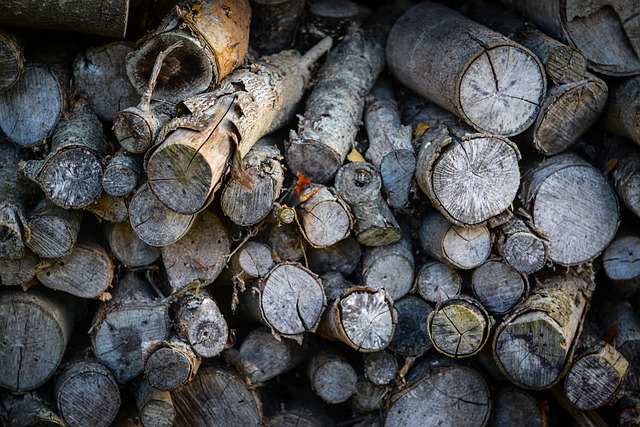Firewood plays a vital role in home heating, and its moisture content is a key factor in how well it burns. As the weather cools down, many of us turn to the comforting warmth of a crackling fire. But have you ever wondered if firewood can be too dry to burn effectively?
Yes, firewood can be too dry to burn effectively. Extremely dry firewood may be difficult to ignite, burn rapidly with reduced heat output, and increase the risk of sparking and chimney fires. Achieving the optimal moisture content of around 20% is key for efficient burning.
I’ll take a closer look at different levels of moisture content and their impact on burning efficiency. But first, let’s make sure we’re all on the same page when it comes to understanding firewood moisture content.
Understanding Firewood Moisture Content
Before I delve into the burning potential of firewood, it’s essential to understand what we mean by “firewood moisture content.” Essentially, moisture content refers to the amount of water present in the wood. The moisture content of firewood can significantly affect its burning characteristics.
Why does moisture content matter? Well, when firewood is burned, the heat generated is used to evaporate the water within the wood before it can produce substantial warmth. This means that firewood with high moisture content requires more energy to evaporate the water, resulting in less heat output and lower overall efficiency.
Different types of firewood can have varying moisture content levels. Freshly cut or “green” wood generally has a high moisture content, typically above 50%. On the other hand, properly seasoned firewood, which has been allowed to dry, usually has a moisture content of around 20% or lower. The lower the moisture content, the better the firewood tends to burn.
Now that you have a basic understanding of firewood moisture content, let’s explore whether firewood can be too dry to burn effectively.
Can Firewood Be Too Dry to Burn?
Can firewood be too dry to burn effectively? The answer might surprise you! While we often associate dry firewood with better-burning performance, there is indeed a point where firewood can become excessively dry, leading to some challenges in the burning process.
When firewood is too dry, it tends to ignite more quickly and burn rapidly. This might sound great at first, but it can also result in a few issues. One of the primary challenges is the difficulty in igniting overly dry firewood. Because it lacks sufficient moisture, it can be stubborn to catch fire initially. You might find yourself struggling to get the fire started, leading to frustration and wasted time.
Furthermore, excessively dry firewood burns faster than wood with a moderate moisture content. This means that even though it ignites easily, it may not provide a long-lasting and sustained heat output. You’ll find yourself needing to add more firewood more frequently to maintain a cozy fire, which can be inconvenient and require more effort.
Another potential risk associated with burning overly dry firewood is an increased likelihood of sparking and chimney fires. When wood is extremely dry, it can release volatile compounds that ignite more easily, leading to sparks that could potentially escape the fireplace or stove and cause accidents. Additionally, the intense heat generated by excessively dry firewood can contribute to the buildup of flammable creosote in the chimney, posing a fire hazard.
So, while dry firewood is generally preferred for efficient burning, it’s important to strike a balance. Let’s dive deeper into its effects on the burning process.
Effects of Very Dry Firewood on the Burning Process
Now that you understand that firewood can indeed be too dry to burn effectively, let’s take a closer look at the effects of very dry firewood on the burning process. While it may seem counterintuitive, extremely dry firewood can present some unique challenges and outcomes.
- Difficulty in Ignition: Very dry firewood lacks the moisture necessary to facilitate easy ignition. Without a moderate level of moisture, it can be a real struggle to get the fire started. You might find yourself resorting to extra kindling, fire starters, or even accelerants to ignite the wood. Patience and persistence are key when dealing with overly dry firewood.
- Rapid Burning and Reduced Heat Output: Once ignited, excessively dry firewood tends to burn rapidly. It releases its energy quickly, resulting in a shorter burn time compared to wood with a more moderate moisture content. While the initial flames might be impressive, the rapid burn can lead to diminished heat output. This means you may not enjoy the sustained warmth you desire and may need to replenish the fire more frequently.
- Increased Risk of Sparking and Chimney Fires: As I mentioned earlier, very dry firewood is more prone to sparking. The lack of moisture can cause the wood to crackle and pop, releasing sparks that can escape the fireplace or stove. These sparks can be a potential fire hazard, especially if they come into contact with flammable materials in your home. Additionally, the intense heat generated by excessively dry firewood can contribute to the buildup of creosote in the chimney, which increases the risk of a chimney fire.
- Decreased Duration of Burn Time: Due to the rapid burning nature of very dry firewood, you may find that your fires don’t last as long as you’d like. You’ll need to add more wood more frequently to maintain a continuous heat source. This can be inconvenient, especially if you’re looking for a long, cozy evening by the fire.
So, while dry firewood is generally desirable, extremely dry firewood can present challenges such as difficult ignition, rapid burning with reduced heat output, increased risk of sparking and chimney fires, and shorter burn times. The key is finding the right balance when it comes to firewood moisture content. In the next section, I’ll explore the optimal moisture content for efficient burning.
Optimal Moisture Content for Efficient Burning
Now that I’ve discussed the potential drawbacks of overly dry firewood, let’s explore the optimal moisture content for efficient burning. Finding the right balance is crucial for achieving a warm and long-lasting fire. So, what is the ideal moisture content range for firewood?
Generally, firewood with a moisture content of around 20% is considered optimal for efficient burning. This moisture level allows for easier ignition, sustained heat output, and a longer burn time. When firewood has this moderate moisture content, it strikes a balance between releasing heat and providing a consistent flame.
To achieve this ideal moisture content, proper seasoning and storage techniques are essential. Seasoning refers to the process of drying firewood to reduce its moisture content naturally. It typically involves allowing freshly cut wood to dry for a period of 6 to 12 months or longer, depending on the wood species and climate conditions. Properly seasoned firewood not only improves burnability but also minimizes the production of excessive smoke and creosote buildup.
To measure the moisture content of firewood, you can use a moisture meter specifically designed for wood. These handy devices provide accurate readings and help you determine whether your firewood is adequately seasoned or if it needs further drying time.
When it comes to storage, it’s crucial to keep your firewood protected from moisture. Ideally, store it in a well-ventilated area, such as a woodshed or covered storage rack. Elevate the wood off the ground using pallets or supports to prevent contact with damp soil. Additionally, ensure proper airflow around the stacked wood to facilitate continued drying and prevent mold or rot.
Using firewood with the optimal moisture content not only improves burn efficiency but also maximizes heat output and reduces the risks associated with overly dry or damp wood.
Let’s explore other factors that can influence the burnability of firewood. Stay with me!
Other Factors Affecting Firewood Burnability
Apart from moisture content, there are several other factors that can affect the burnability of firewood. Let’s take a look at these factors and how they can impact your firewood burning experience.
- Wood Species: Different wood species have varying burn characteristics. Some species, like oak and maple, are known for their high energy content and long burn times. Others, such as pine and cedar, tend to burn more quickly and produce a pleasant aroma. It’s essential to consider the wood species you’re using and its specific burning qualities to achieve the desired results.
- Size and Shape: The size and shape of your firewood pieces can influence how well they burn. Generally, smaller pieces tend to ignite more quickly and provide a faster burst of heat, while larger pieces burn more slowly and provide a longer-lasting fire. It’s a good idea to have a mix of different sizes to cater to your specific needs and preferences.
- Airflow and Ventilation: Adequate airflow is crucial for efficient combustion. When arranging your firewood, leave space between the logs to allow oxygen to reach the fire. Proper ventilation, either through a fireplace damper or stove vents, ensures that the fire receives the necessary oxygen for optimal burning.
- Weather Conditions: Weather conditions, such as humidity and temperature, can affect how well firewood burns. High humidity levels can make it more challenging to ignite and sustain a fire, while dry and cold conditions promote better-burning efficiency. Keep these factors in mind when planning your fires, especially during humid or rainy periods.
In the next section, I’ll share practical tips for using firewood effectively.
Practical Tips for Using Firewood Effectively
Now that I’ve covered various factors affecting firewood burnability, let’s explore some practical tips for using firewood effectively. These tips will help you make the most of your firewood and ensure a cozy and efficient fire.
Selecting and Sourcing Firewood:
- Choose hardwood species known for their excellent burning qualities, such as oak, maple, or birch.
- Purchase firewood from reputable suppliers to ensure quality and proper seasoning.
Proper Storage Techniques:
- Store your firewood in a well-ventilated area, protected from moisture.
- Stack the wood off the ground using pallets or supports to prevent contact with damp soil.
- Cover the top of the stack to shield it from rain or snow while allowing airflow.
Preparing Firewood for Burning:
- Split larger logs into smaller pieces to facilitate easier ignition and a more controlled burn.
- Remove any excess bark or debris that may hinder combustion.
Building and Lighting the Fire:
- Arrange your firewood with proper airflow in mind, leaving space between the logs for oxygen circulation.
- Use kindling, such as small twigs or newspaper, to help ignite the fire.
- Avoid using accelerants like gasoline or lighter fluid, as they can be dangerous and produce unpleasant odors.
Maintaining Safety Measures:
- Install smoke detectors and carbon monoxide detectors near your fireplace or stove and regularly test them.
- Keep a fire extinguisher nearby and know how to use it in case of emergencies.
- Never leave a fire unattended and ensure it is fully extinguished before leaving the room or going to bed.
Regular Chimney Maintenance:
- Schedule regular chimney cleanings to remove creosote buildup and ensure proper ventilation.
- Inspect the chimney cap and spark arrestor to prevent sparks from escaping and causing fires.
Conclusion
In conclusion, while dry firewood is generally preferred for efficient burning, there is a point where firewood can become excessively dry, presenting challenges in the burning process.
you’ve learned that extremely dry firewood can be difficult to ignite, burn rapidly with reduced heat output, increase the risk of sparking and chimney fires, and result in shorter burn times. It’s important to find the right balance when it comes to firewood moisture content.
Optimal moisture content for efficient burning is around 20%. Proper seasoning and storage techniques are essential to achieve this moisture level. Seasoning firewood involves allowing it to naturally dry for several months, while storing it in a well-ventilated area protects it from moisture.
There are other factors that can affect firewood burnability, such as wood species, size and shape, airflow, and weather conditions.
To use firewood effectively, follow the practical tips above, including selecting and sourcing firewood wisely, properly storing and preparing firewood, building and lighting the fire, maintaining safety measures, and scheduling regular chimney maintenance.
Now, armed with this knowledge, you can enjoy the warmth and ambiance of a well-burning fire while ensuring safety and efficiency.
Thank you for joining me on this exploration of firewood burnability. I hope you found this article helpful and informative. If you have any further questions or experiences to share, please feel free to leave a comment. Stay warm and cozy.
You may also like to read: What Wood Burns The Hottest?










